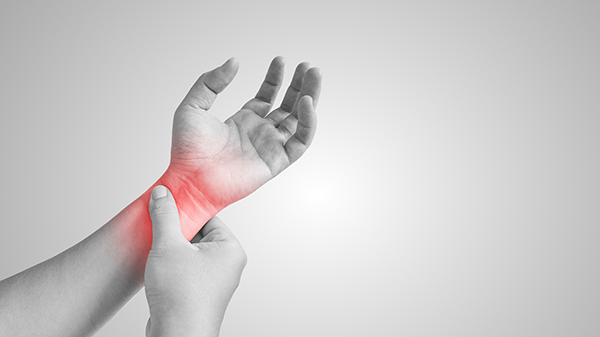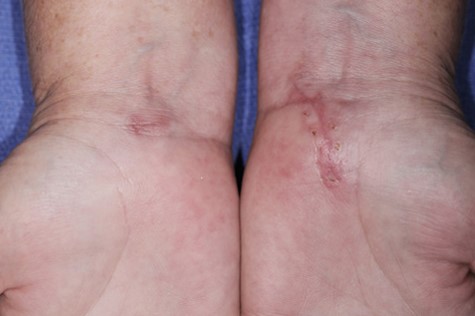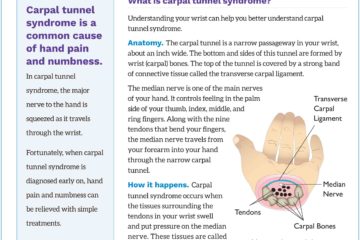Microinvasive Carpal Tunnel Surgery

CARPAL TUNNEL SYNDROME
What is Carpal Tunnel Syndrome?
Carpal tunnel syndrome affects more than 12 million Americans and results in 500,000 surgeries every year.
Carpal tunnel develops when the median nerve in your wrist becomes compressed. Your median nerve is involved with muscle movements and sensations in your fingers and hand.
The median nerve starts in your upper arm and runs through your forearm before ending in your hand. As the median nerve passes through your wrist, it travels through an area called the carpal tunnel.
The carpal tunnel is a group of ligaments, tendons, and bones. If the carpal tunnel swells, there’s less room for your median nerve. This narrowing leads to constriction of your median nerve and impacts your hand and finger function.
Carpal tunnel can occur in anyone but happens more frequently in women.
What are the symptoms of carpal tunnel?
Carpal tunnel causes a variety of symptoms, especially in your thumb, index, middle, and ring fingers. It’s common to experience:
- Tingling, numbness, and pain
- Difficulty grasping things
- Clumsiness or weakness in your thumb
Many people find that their carpal tunnel symptoms worsen in cool temperatures, in the evening, or during certain activities. You might also drop things more frequently.
If you’re suffering from the symptoms of carpal tunnel syndrome that don’t respond to conservative treatments like steroid injections and pain relievers, Dr. T might recommend surgical options, like carpal tunnel release, to address your condition

Which One would you choose?
What is Micro-invasive carpal tunnel release?
Carpal tunnel release surgery creates more room for the median nerve and tendons to move through the carpal tunnel. This outpatient procedure can relieve pain and restore function to your hand and finger.
There are two primary approaches to carpal tunnel release surgery: the traditional method using a large incision and minimally invasive endoscopic carpal tunnel release.
Traditional open and endoscopic carpal tunnel release (CTR) procedures can be effective but may result in a lengthy recovery period and a large and sometimes painful scar.
The Microinvasive approach is an innovative surgical device that enables Micro-invasive Carpal Tunnel Release through a single micro-incision about 1-2 cm under.
After having carpal tunnel release, your wrist is often bandaged for a week. Most of our patients do not need physical therapy. The usual recovery time is within 1-2 weeks but you can start using your fingers and hands with some restrictions the day after surgery.
Micro invasive techniques can result in a faster recovery time and minimal scarring.
If you suffer from any of the symptoms of carpal tunnel syndrome, contact Dr. T for a consultation. Their caring staff will be honored to take care of you.

HANDS UP! Who is ready to Feel a "HAPPY" hand?
Enter the information to download our FREE “Carpal tunnel syndrome eBook” to learn how we can help you

REQUEST APPOINTMENT
If you are suffering from low-back pain, neck pain, herniated disc, sciatica, pinched nerve and have been researching minimally invasive spine surgery as well as laser spine surgery, schedule an appointment to speak to Dr. T and Microspine Team today.
REQUEST APPOINTMENT
If you are suffering from low-back pain, neck pain, herniated disc, sciatica, pinched nerve and have been researching minimally invasive spine surgery as well as laser spine surgery, schedule an appointment to speak to Dr. T and Microspine Team today.
Microspine
Office
14300 N Northsight Blvd, #213. Scottsdale, AZ 85260
Phone: 602-833-2141
Fax: 602-610-3878
Office hours M-F: 8 AM to 5 PM
By appointment only
Dr. T serves the areas of Anthem, Apache Junction, Avondale, Buckeye, CasaGrande, Cave Creek, Chandler, Flagstaff, Fountain Hills, Gilbert, Glendale, Goodyear, Laveen, Maricopa, Mesa, Paradise Valley, Payson, Peoria, Phoenix, Prescott, Prescott Valley, Queen Creek, Safford, SanTan, Scottsdale, Sedona, Showlow, Suncity, Suncity West, Tempe, Tucson, Yuma, and surrounding areas.
